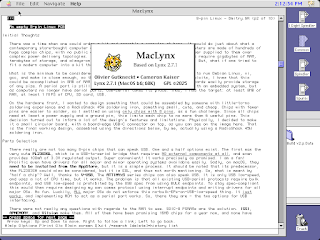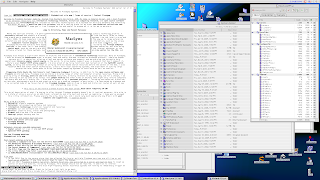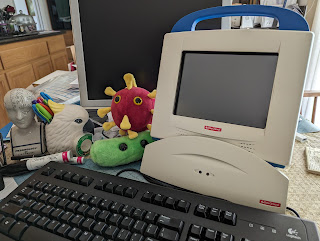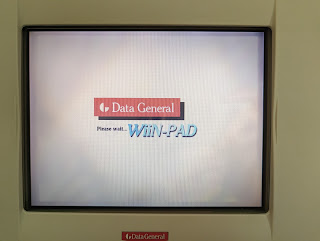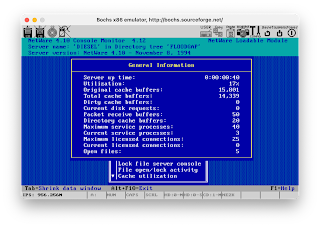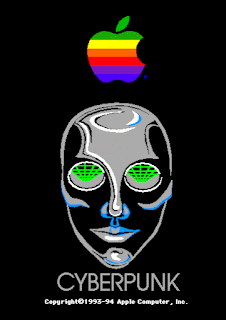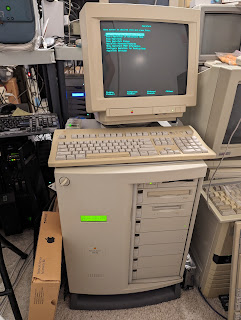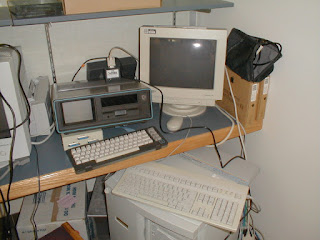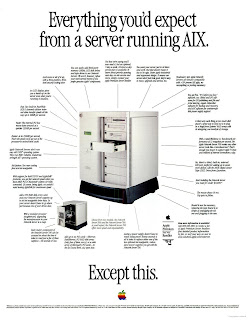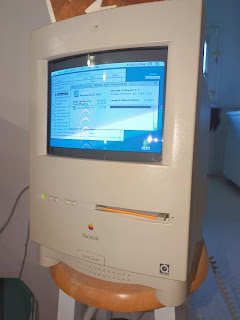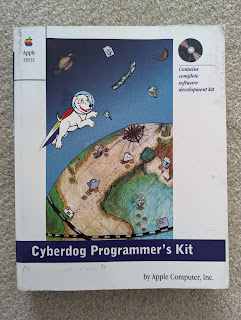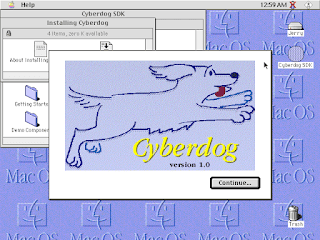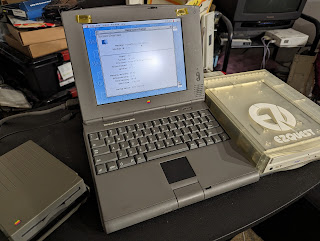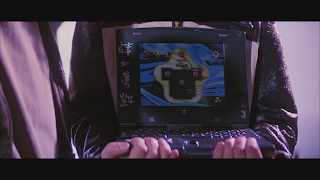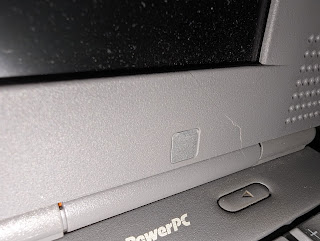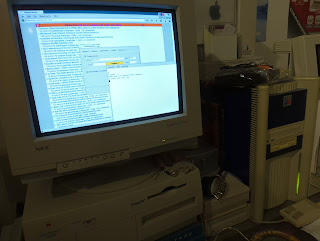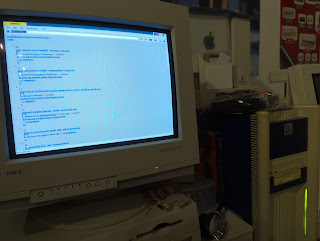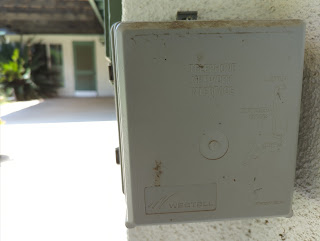Saturday, April 5, 2025
MacLynx beta 6: back to the Power Mac
Saturday, May 4, 2024
With PowerPC, Windows CE and the WiiN-PAD slate, everyone's a WiiN-er (except Data General)
And, well, no. I can't think of a single product from that particular salvo that actually survived, let alone thrived. But we've got one of them here — and, as you might expect, there's a few odd things about it. First off, it's a slate. (We call them tablets now, kids.)
Not a vanishingly rare form factor for a Windows CE device, though hardly the most common. It's also got a full-size dock, a camera and ... a Data General badge? The Nova-AViiON-CLARiiON-Data General/One Data General that put two I's into everything? Yup, it's really that Data General with that naming convention. In fact, as the history will show, the Data General WiiN-PAD is quite possibly the last computing device DG ever produced before EMC bought them out and shut (most of) them down in 1999. (No, near as I can determine, the name WiiN-PAD has nothing to do with the unreleased Microsoft WinPad.)But that's not the really wacky part. Check out the CPU it's running.
That's right: it's PowerPC, the most unloved of the architectures CE ever ran on — in fact, this is the first PowerPC Windows CE device I've ever found, and I'm the self-described biggest pro-PowerPC bigot in the world. Here's an unusual form factor Windows CE device, running on the operating system's least used CPU, from a storied computer company near the end of its run, intended for medical applications, produced in very small numbers and cancelled within months.What are we going to do with it? Well, what do you think we're gonna do with it? We're going to program it, so that we can finally have some software! And, of course, since this wacky thing was there at the bitter end, we'll talk more about the last days of Data General and what happened next.
Saturday, December 23, 2023
When the Power Macintosh ran NetWare (featuring Wormhole and Cyberpunk)
Why, the very mention of NetWare almost certainly caused those of you familiar with it to get an instant mental image of MONITOR.NLM, like this as shown in Bochs:
But Novell wanted NetWare servers to be more than just PCs (and the PC ecosystem to be more than just Microsoft), and in an attempt to gain footholds elsewhere the company accumulated some strange bedfellows. HP, Sun and Data General were on board, and IBM did so in grander form, but surely the most unexpected company Novell tried to court was ... Apple. Yes, that screenshot is a real Power Macintosh 6100 (actually a Performa 6116CD) in the Floodgap lab running exactly what you think it's running. As a matter of fact, that Apple logo superimposed on the '90s Novell "teeth" I led off with was a real resource image that came from it.No, I don't mean Macintoshes accessing NetWare servers as clients: we mean Macs as NetWare servers themselves. As proof, we'll take an entire tour of Power Macintosh NetWare on the 6116CD and try to boot it on the Apple Network Server, its actual intended target. NetWare on the Mac really existed as part of the same bizarro universe that ported the Macintosh Finder to Novell DR-DOS — meaning it's time for yet another weird Apple story during Apple's weirdest days.
Saturday, November 11, 2023
The Apple Network Server's all-too-secret weapon (featuring PPC Toolbox)
About a year later the University said they'd throw it in with my consultant compensation because they wanted to get rid of it anyway, so it became officially mine, and I was delighted to have it. That machine, later upgraded to 200MHz and 512MB of parity FPM RAM, variously powered my E-mail and the Floodgap gopher and webservers from 2000 to 2012, and still does backup duty when the POWER6 has to be down for repairs.
That's because the POWER6 runs everything the ANS did — because the ANS also runs AIX. The ANS 500 and 700 were not Apple's first Unix-specific servers (that would be the Apple Workgroup Server 95, a Quadra 950 using a special PDS card that only worked with A/UX, Apple's own Unix with a bolted-on Mac compatibility layer), but they were Apple's first Mac derivatives that could not boot classic Mac OS at all and natively ran a non-Apple operating system. Indeed, most people treated it as exactly that, a big Unix server from Apple, and at the time I did too.However, there was a secret weapon hidden in ANS AIX most of us at the time never knew about. Built-in to the operating system was a fully Unix-native AppleTalk stack and support for receiving and sending Apple Events, surfaced in the form of Apple's disk administration tools and AppleShare. But Apple had a much more expansive vision for this feature: full server-client "symbiotic" applications that could do their number-crunching on the ANS and present the results on a desktop Mac. Using the Program-to-Program Communication Toolbox ("PPCToolbox"), and because AIX's throughput far exceeded anything the classic Mac OS ever could ever handle, an ANS could augment a whole bunch of Macs at once that didn't have to stop to do the work themselves.
Well, today we're going to write one of those "symbiotic" applications doing something this little Mystic Color Classic could never efficiently do itself — accessing and processing a JSON API over TLS 1.3 — and demonstrate not only how such an client application looked on the Mac side, but also how the server component worked on the AIX side. If you're lucky enough to have an ANS running AIX too, you can even compile and run it yourself. But before we do that, it might be a little instructive to talk about how the Apple Network Server came to run AIX in the first place.
Saturday, October 14, 2023
Teaching Apple Cyberdog 1.0 new tricks (featuring OpenDoc)
Cyberdog's initial release belied some wild changes afoot, for in the world it inhabited, the document told the system what it needed to display, and the parts within the document displayed it. The document ruled all. The document was king.
And all of this came together in a special Cyberdog software development kit, complete with example code and the very first 1.0 release of the browser. Now that we have our PowerBook Duo 2300 rehabilitated, guess what we're gonna look at?
Saturday, September 2, 2023
Refurb weekend: PowerBook Duo 2300c
But being Apple's smallest laptop — even today the Duos are still the fourth smallest, width-height-wise — wasn't the (main) point of the Duos. Arguably, the main point was the Dock. Even Jerry Seinfeld had one.
With the Dock, your little, relatively underpowered laptop was hoovered up into a beige plastic maw to make it into an average-sized, somewhat less underpowered desktop. But you got slots and ports and the ability to use it like a desktop computer — two computers in one! — and that was crucial because without any Dock, even the smaller Mini and MicroDocks, you had hardly any ports at all (MacBook Air has entered the chat). Docking was so important that Apple even intentionally gimped the 2300 by keeping the 100MHz 603e on a 32-bit bus to maintain Dock compatibility. Yet because Duos were irrepressibly cute, they turned up in many other TV shows and even movies, most notoriously Hackers: (People hate on Kate Libby's offhand comment that it has the new "P6 chip" especially when the trackball gives it away as a 68K Duo, but allegedly the unit in the film had a 2300 logic board, Apple did call the 60x series "P6" in some marketing material, and the "28.8 bps" [sic] modem did at least exist as a prototype. The greater technical sin is Dade Murphy saying it has a PCI bus even though no Duo ever did; the first PowerBook to be PCI was the 3400.) Unfortunately, one of my two 2300c systems is showing evidence of the same problem that ruined the front of my favourite PowerBook 1400: the metal hinges are starting to tear out of their attachment points in the plastic back of the display, and naturally it's the one with all the upgrades in it. The most common symptom, besides bulging or split hinges when the display is closed at the point where the back and front come together, is the bottom front bezel cracking from the strain as you open it. If you learn one thing from this blog post, when opening pre-G3 PowerBooks, place your thumbs on each side of the bottom bezel of the display as you open them to support the hinge attachments. It's time for a Refurb Weekend.
Saturday, October 8, 2022
Going where BeOS NetPositive hasn't gone before: NetPositive+
(How do you pronounce BeOS?)
This is a real 133MHz BeBox running otherwise stock BeOS R5, surfing Hacker News and Lobste.rs using a modified, bug-fixed NetPositive wired to offload encryption to an onboard copy of Crypto Ancienne (see my notes on the BeOS port). NetPositive is the only known browser on the PowerPC ports of BeOS — it's probably possible to compile Lynx 2.8.x with BeOS CodeWarrior, but I've only seen it built for Intel, and Mozilla and Opera were definitely Intel/BONE-only. With hacks for self-hosted TLS bolted on, NetPositive's not fast but it works, and supports up to TLS 1.2 currently due to BeOS stack limitations.
Monday, May 30, 2022
So long, home T1 line; hello, hacking the T1 router
T1 lines have never been cheap, though back in the day they were prized because at 1.536 Mbit/s each way they were comparatively high capacity. At my first job out of college in 1997 the university had a T1 connected to an AdTran CSU/DSU, adding more T1 lines on and bonding them for additional bandwidth until they upgraded to optical fiber. A friend of mine in the very late 1990s had his own residential T1 (this was when consumer DSL was uncommon and 56K dialup was still frequent) that his employer paid the bill for, reportedly close to a cool grand a month in those days; he would never been able to afford it otherwise. On a cost basis alone (and certainly dollars per megabit) a T1 would have been far from my first choice, but I needed a reliable server-grade connection and I couldn't find any other alternatives at the time, so if I wanted to get my hardware back online from the house I was going to have to pay up and get one. Rather than use the actual telephone company I went with an overlay vendor and was quoted $295 a month on an annual contract for a 16-address netblock plus $199 installation. Now going into my fourth week of downtime, I signed immediately. They called the telco who came out the next week, installed the smartjack (we'll talk about what this is), took over both telephone wire pairs to the house and wired it into the pedestal — conveniently, the local telco pedestal is literally in my backyard. Good thing I'd already moved the house alarm modem to a wireless connection since I could no longer have a landline now. I then ran lines from the smartjack into the server room (thanks to the telephone guys I used to work next to when I was consulting I already had good experience with a punchdown tool), the vendor came out the week after that with the T1 router, and finally Floodgap was back up.
The original idea was to use the T1 until something less expensive came along, but the T1 just plain worked and was always highest priority on service calls, so inertia and inflation eventually turned the $295 a month into $399 and a 12-month contract into 48. Still, it was a tariffed line with a service-level agreement, I had plenty of addresses and my personal bandwidth requirements have always been modest — I don't cloud, I rarely stream and YouTube is worse than television — so I ended up just using the T1 as my personal ISP at the same time and avoiding a second bill. This worked out fine for awhile except, of course, for love. My wife needed her Netflix and her iCloud, and by then the previously intransigent cable provider had been bought by someone else (fiber? hahahaha) who didn't know any of the previous history; they came out and finally pulled an RG-6 cable run five years after the fact, and switched us on. I moved the Wi-Fi to the new cable net and her bandwidth needs were thus met in the manner to which she was accustomed. We joke about the his'n'hers networks: I still had my lab and servers on the T1, and everything else including her devices was on the cable.
Well, it was good we did that because I mentioned in January this year that the vendor (which had changed owners twice over the years) was abruptly getting out of the residential T1 business and I had a month before it was switched off. I may well have been their last customer in the region. So I'd like to publicly thank John who reached out and offered a no-strings VPN arrangement — which I'm routing over the cable — to keep Floodgap online while we consider our housing options in a market as bad as it was good when I first bought the place. We turned the VPN on and the vendor turned the T1 off. They never asked for the router back and the smartjack still sits in the back of the house.
Now it's Memorial Day in the United States and I suppose I'll have to do something about that now superfluous wiring run sometime soon. Before I do, though, let's document the T1 for a generation who may have never seen one ... and figure out something fun to do with the router they left behind other than, you know, routing stuff.
Like every computing story, this one begins with a box.
Sunday, March 7, 2021
Over the weekend: Commodore 128DCR keyboard extension, updates to Be-Power
Also, I was pointed to some additional BeOS PowerPC files, so I deduped and sorted them, and they are on Be-Power. Among other things there are now many more apps and also some of the OS updates. I also heard from someone who claims to have the old ftp.be.com archive completely mirrored, though for obvious reasons I'm mostly just interested in the PowerPC stuff. Haven't heard back from him yet when I asked for more details, but that's very encouraging for having a nearly complete mirror.
